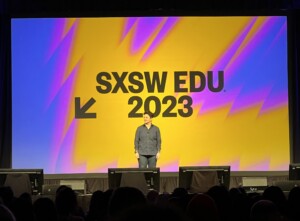The Shift Is On: iNACOL Conference Attendees Inventing the Future of Learning

When I joined the iNACOL board three years ago, I was hoping to see a shift in emphasis from virtual schools to a focus on helping all schools incorporate online and personal digital learning. That shift was evident in the name, Inventing the Future of Learning, and content of the Virtual School Symposium program this week in New Orleans.
“There has never been a more exciting time than what we’re experiencing right now,” said John Bailey, Executive Director of Digital Learning Now!. To the 2,000 people at the closing breakfast Bailey said, “You are like the Silicon Valley of education–thinking out of the box, out in to the future, willing to challenge assumptions, willing to try new things.”
On the subject of iterating toward improvement, Karen Cator, who directs theOffice of Education Technology, quoted UW’s Zoran Popovic on the building the Refraction game, “I want 250,000 people using it so I can make it better.” Cator noted how different that was from the old idea of perfecting a product and making a big release. She suggested that schools can “create, scale, and improve.” She added, “Don’t worry about making it bullet proof, get people involved!”
Bailey noted the “huge momentum” with digital learning bills proposed in nearly every state this year–most advance learning, but some to erect new barriers. He mentioned that we need to create freedom to innovate by removing roadblocks. Bailey noted expansion of choice to the course in Utah, Louisiana, and Georgia. But Bailey cautioned that “Dumping computers in to schools won’t make things better any more than dumping computers into a government agency will improve public services.”
On policy development, Michael Horn, who moderated the closing session with Cator and Bailey, said “Don’t enshrine definitions into law when the space is so dynamic.” He suggested that most state officials haven’t see blended programs, “Don’t assume elected officials have the same knowledge, or are reading the same report.” Allowing policy makers to hear from teachers and students cannot be underestimated. ” Horn suggested bringing officials to innovative schools or bringing students to the capital. Bailey also highlighted, “We can not rest on past successes; we need to focus on the next advocacy challenge.”
Cator, as she often does, said “Don’t get caught in the false choices of teachers versus technology, or books versus computers–it’s all about vastly improving the learning of every single person.” She added, “We just need to figure out the access challenge. There are plenty of quality opportunities to learn if we have broadband and access in the students hands.”
General session highlights included Stacey Childress and Louisiana Superintendent John White , Chic Thompson on habits of mind for innovation and Susan Patrick closed the final session with a thank you to the program committee who pulled together an amazing list of sessions that informed, challenged and inspired the VSS attendees. “Don’t stop believing” says Patrick.
Six Trends. We saw the following six trends at Virtual School Symposium 2012, the iNACOL conference:
1. Creative tools and schools that will leave behind outdated models for new ways to teach and learn.
2. Competency-based learning was big at #VSS12. See iNACOL’s online communityCompetency Works for more.
3. Personalized learning backed by big data is around the corner with the help of adaptive systems, background assessments, and easy-to-use tracking systems. Benefits will include increased student agency, higher engagement and improve outcomes.
4. Educational choice was discussed but with a new twist–digital learning is redefining stale debates on choice and replacing it with conversations about customization.
5. Bring your own device (BYOD) is a growing solution for schools looking to turn the budget crisis into a budget opportunity. More than 30 percent of attendees at the session “You’re Already BYOD” featuring Riverside Unified School District said they were using BYOD policies in their school or district.
6. Rethinking systems and reimagining what schools and classrooms look like in the future when you put this list together. Keynote speakers Monday morning shared some effective ideas for education innovation.
Advocacy. The meta-trend with iNACOL is a strategic shift to policy advocacy. Under Susan Patrick’s leadership iNACOL has emerged as one of the most important digital learning advocacy group (along with Innosight Institute and Digital Learning Now!). iNACOL is serious about better online schools and learning options. With support from the Gates Foundation, iNACOL developed a quality framework (released at the conference) stressing the shift from inputs to outcomes.
It was great to be back in New Orleans, which in seven years has emerged from disaster to become a hub of innovations in learning and public policy. It was great to be around 2200 iNACOL members that are inventing the future of learning.
This blog first appeared on EdWeek.






0 Comments
Leave a Comment
Your email address will not be published. All fields are required.